The most significant natural disaster risk to UK homes is flooding. And climate change is only compounding this risk. One of the most difficult aspects of flooding is its unpredictability. Floods can overwhelm towns and cities in a matter of hours as we’ve seen in Norfolk, Cambridgeshire and Oxfordshire during Storm Bella in late 2020. Yet the extent of flood damage can depend on the measures that homeowners have adopted to protect their homes (also known as property flood resilience measures, or PFR). With this in mind, we have worked with the Environment Agency (EA) and WPI Economics to understand how we can use behavioural science to encourage homeowners to adopt PFR measures.
Testing approaches to increase the flood resilience of homes in England
Today, we publish a report which discusses the results of three randomised controlled trials with WPI Economics and the EA to encourage property flood resilience measures. Our trials tested changes to ‘personal flood plans’, EA social media ads, and online information about how to prepare for floods.
We found evidence of effectiveness for:
- Making it simple: Simplifying and shortening online flood preparation information.
- Rationale building: Giving people short explanations for why they should carry out behaviours along with advice on how to do so.
- Future self thinking: Encouraging people to imagine their ‘future self’ in a flood, prompting them to think through the actions and decisions they would take.
- Reciprocity: Applying a ‘reciprocity’ approach to appeals to prepare for flooding, emphasising the government’s work to protect communities from flooding and asking individuals to ‘do your bit too.’
- Role models: Providing a ‘social model’ who installed PFR measures and benefited from it.
Download the report
Improving personal flood plans
A ‘flood plan’ is a document which helps homeowners plan what they would do in a flood – where to move valuable items, how to turn off electricity and gas, and who to call for help.
We made four new versions of EA’s standard flood plan:
- Simplified flood plan. We made the flood plan easier to understand and fill out by reducing the number of actions required and breaking behaviours down into manageable steps.
- Context: We provided explanations for suggested actions to help users understand the purpose of each suggestion.
- Images: We added pictures and icons to make the flood plan more engaging.
- Future self: Participants completed a short exercise before filling in the simplified flood plan. The exercise prompted them to reflect on how a flood could impact their future self; we hypothesised that this would make respondents more motivated to complete their flood plan.
Excerpt from future self exerciseImagine that there is flooding in your area. Water has started to enter your home, and is rising. You hear an announcement on the radio that residents in your area are being advised to evacuate as soon as possible. You don’t have long to get out – what three items would you quickly take with you? Please fill in your answers as quickly as you can! ❏ [Open text box] ❏ [Open text box] ❏ [Open text box] |
We conducted an online experiment with 3,866 English homeowners to test the impact of the new flood plans compared to (1) the current EA flood plan; and (2) no flood plan at all. Respondents were randomised to complete one of the flood plans via an online platform, and were then asked a series of survey questions.
We found that all four of our new flood plans led to improvements in our primary outcome measure: how useful respondents found the flood plan.
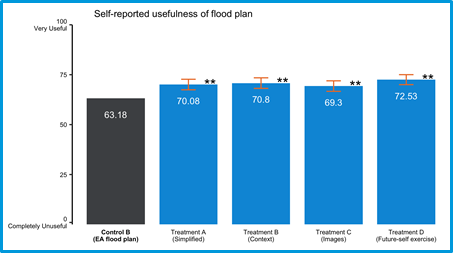
The flood plans also improved respondents’ understanding of which actions they should take in the event of a flood and their sense of preparedness for a flood.
This shows that simplifying the flood plan improves its effectiveness, and provides preliminary evidence that providing context or a ‘future self’ exercise can further improve the efficacy of flood plans.
Download the report
Increasing engagement with social media ads about flooding
EA runs regular social media campaigns which include videos and links to pages explaining what to do if a flood strikes.
BIT worked with EA’s social media campaign to apply behavioural science to their flood action ads. We developed two new versions of the advertisements:
- Location reciprocity: we leveraged reciprocity – the idea that if someone does something kind for you, you’re more likely to ‘repay’ them by doing something for them – by emphasising that the government is working to protect homeowners from flooding, so homeowners should do ‘your bit too’.
- Location risk: we emphasised that flooding poses a risk to homes in the user’s location.
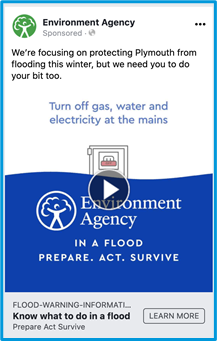
We then conducted a field experiment using EA advertisements on Facebook and Instagram. The ads reached a total of 2,879,093 people.
We found that the location reciprocity framing was the most effective at increasing both the video play and click-through rate.
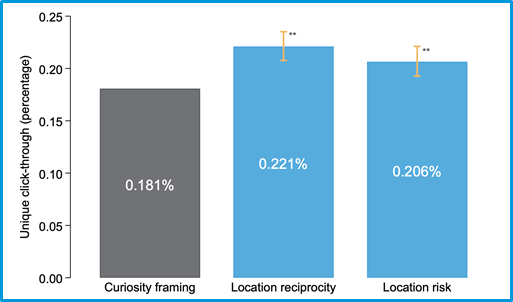
Download the report
Improving the ‘prepare for flooding’ webpage
EA’s ‘How to plan ahead for flooding’ webpage explains how homeowners can protect their home from flooding. We created three new versions of the webpage which applied behavioural science to make it more engaging:
- Social modelling: We used a home-owning couple to act as a case study to show how PFR measures can be used to protect against flooding.
- Chunking of information: We broke the information on the webpage into manageable ‘chunks’ to make the information easier to understand and put into practice.
- Chunking of information + images. In addition to simplified text, we used visuals to make the information in the webpage more salient and easier to understand.
We ran an online RCT with 4,196 homeowners to test the efficacy of the three treatment versions compared to the EA beta ‘How to plan ahead for flooding’ webpage. We also compared the EA beta to (1) a similar page managed by the Government Digital Service; and (2) not seeing a webpage at all (the ‘pure control’).
None of our treatments led to improvements to our primary outcome measure (a combined response- and self-efficacy measure).
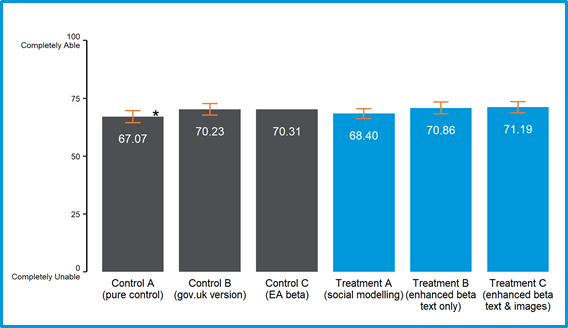
However, our exploratory analysis suggests that the ‘social modelling’ condition led to improved awareness of which measures can be used to protect properties from flooding.
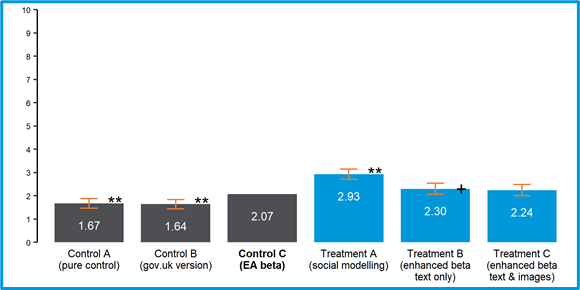
Next steps
As the UK turns its attention to reducing its greenhouse gas emissions to ‘net zero’ by 2050,it will also need to adapt to an already changing climate. This means investments in flood resilience by both the government and homeowners themselves.
Our work suggests a few solutions that the government, local authorities, and other organisations encouraging homeowners to adopt PFR measures should consider: applying reciprocity framing in communications, explaining the purpose of key PFR measures when recommending them, inviting people to consider how their ‘future selves’ would respond in floods, and providing social models who have benefited from adopting PFR when recommending measures to prepare for floods.





